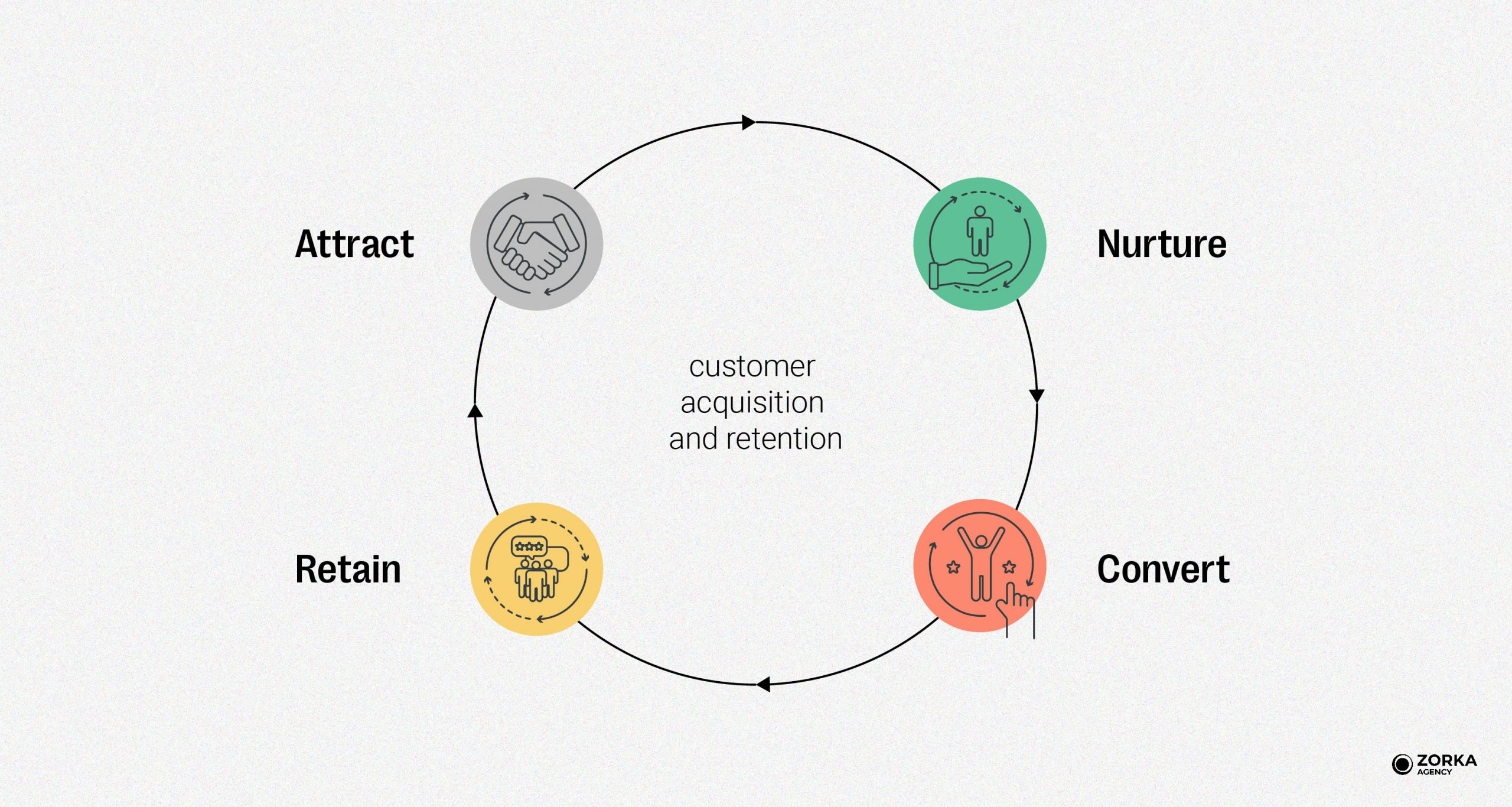Crafting Enduring Connections: Mastering Customer Acquisition
Getting customers isn’t just about making a sale; it’s about crafting enduring connections. From the initial encounter with a brand to their first purchase, every interaction is a golden opportunity to ignite excitement and empowerment. Let’s delve into the crucial aspects of customer acquisition, including challenges and strategies for improvement.
Keep reading to explore the challenges and discover strategies to elevate your customer acquisition game, shared by our Head of UA, Karina.
What Is Customer Acquisition?
Getting new customers onboard is all about attracting and converting potential buyers into loyal customers. It all starts with the first interaction they have with a brand or product and ends with their first purchase. To achieve this, a robust acquisition plan should include several key elements:
- Attract leads: Use various marketing channels to connect with potential customers by telling stories that resonate with them;
- Nurturing those leads: Build relationships by understanding their needs and providing personalized support, gaining their trust and confidence;
- Converting the leads into paying customers: Employ smart sales tactics and streamline the buying process to seal the deal;
- Retaining those new customers: Keep customers happy with top-notch products/services, proactive support, and ongoing value to encourage repeat business and referrals.
The ultimate goal is to establish a systematic and sustainable approach to continually bring in new customers, driving business growth and revenue.

What Are The Most Common Challenges In Customer Acquisition in 2024?
When it comes to acquiring new customers, several consistent challenges need to be addressed. First, it’s crucial to optimize value propositions while keeping pricing competitive. This requires understanding and adapting to changing customer preferences. Second, increasing customer service expectations demands transparency, promptness, and responsiveness to build and maintain brand credibility. Third, aligning marketing and sales teams seamlessly is essential to deliver on promises and provide consistently personalized experiences. Lastly, staying updated on technological advancements is necessary to remain competitive, but this also involves carefully managing associated costs and making operational adjustments.
Additionally, focusing on customer retention is vital. Retaining existing customers is generally more cost-effective than acquiring new ones. This involves providing continuous value, fostering loyalty, and implementing effective feedback mechanisms to anticipate and address customer needs. Poor customer retention can harm a brand’s reputation, signaling to the market that the product or service may not meet expectations. High churn rates make it harder to attract new customers, who may be deterred by seeing others leave. Retained customers offer valuable feedback for improvement, which is essential for attracting new customers. While retention is more cost-effective, struggling with it can increase overall costs, impacting acquisition efforts. Thus, finding the right balance between retention and acquisition is essential for sustainable business growth.
Refining Your Approach: Six Practical Steps For Improvement
Enhancing your customer acquisition strategy requires a holistic approach that revolves around understanding your audience, optimizing your channels, leveraging data, prioritizing customer value, and embracing automation. By delving deeper into these aspects, you can fine-tune your approach and drive more effective results.
1. Continuously refine your target audience’s understanding
Conduct ongoing research to deepen your knowledge of your target audience’s needs, pain points, behaviors, and decision-making factors. Use surveys, feedback, data analysis, and competitive research to refine your buyer personas and audience segmentation.
2. Optimize your channel mix
Regularly review the performance of your acquisition channels (website, email, social media, paid ads, etc.) and reallocate resources to the highest-performing ones. Test new channels that align with your audience’s preferences.
3. Leverage data and analytics
Utilize data from website analytics, marketing campaigns, and customer interactions to identify areas for optimization. Conduct A/B testing, analyze user behavior patterns, and make data-driven decisions to improve conversions and ROI.
4. Focus on customer value and retention
Implement strategies to enhance the value proposition for existing customers, such as new product offerings, upgrades, referral programs, and loyalty programs. Retaining customers is more cost-effective than acquiring new ones.
5. Embrace automation and personalization
Automate repetitive marketing tasks like email nurturing, lead scoring, and follow-ups to improve efficiency. Use personalization and segmentation to deliver tailored messaging and offers that resonate better with specific audience segments.
6. Take it further
Understanding and leveraging both internal and external triggers is essential for enhancing user retention. Internally, users are influenced by emotions and habits, while external factors like emails and push notifications play a vital role in re-engagement. Utilize usage data to strategically time these triggers, adapting tactics based on experimentation results. Ensure message relevance and value amidst evolving email regulations by utilizing multiple channels. Segment users for paid retargeting, prioritizing high-retention channels. By integrating personalization, timing, and optimization, create a compelling user experience fostering long-term loyalty.
The key is to take a data-driven, customer-centric approach, continuously test and optimize, and focus on delivering value throughout the customer lifecycle to improve acquisition and retention.
In Conclusion
Mastering customer acquisition entails more than just securing a sale; it’s about forging enduring connections that fuel sustainable growth. Understanding the journey from initial engagement to conversion is pivotal, requiring a strategic blend of attracting, nurturing, converting, and retaining customers. Despite consistent challenges such as evolving market dynamics and rising customer expectations, optimizing value propositions, aligning marketing with sales, and embracing technological advancements are paramount. By continuously refining target audience understanding, optimizing channel mix, leveraging data, prioritizing customer value, and embracing automation, businesses can enhance their acquisition strategies and drive long-term success. Ultimately, a data-driven, customer-centric approach underpins effective acquisition and retention efforts, ensuring continued business growth and profitability.